Can you imagine the size of all the data on the internet? In 2024 it was calculated at 149 zettabytes – a trillion gigabytes – and by 2028, the volume of all the data in the world is likely to reach 394 zettabytes!
This explosion of information continues to grow with every click, as countless data sources add to the pile. While past innovations in big data development have helped companies store and sort their data, enough as the volume of data grows. Every customer interaction holds valuable insights for businesses – so how can you analyze this mountain of data effectively?
Big data and AI are powerful on their own but game-changing together. Let CHI Software show you how.
Start with a consultation
Let’s be realistic: manual analysis is not an option for big data because it can lead to mistakes. Traditional software just can’t keep up with the scale and complexity of modern data. Yet, there is the technology that can sift through huge amounts of data, identify patterns, and provide organizations with accurate conclusions, and does so much faster than humans. You guessed it: this technology is artificial intelligence.
But is AI really as powerful as all the hype suggests? CHI Software is here to show how big data and AI work hand-in-hand, how to combine these two technologies to achieve maximum results, and how you can start implementing big data and AI strategies for your business.
Article Highlights:
- AI instantly comprehends vast amounts of data in various formats, so using big data for AI provides reliable information that makes algorithms faster and progressively more reliable every day;
- Intelligent data pipelines power complex systems created by using AI and machine learning (ML) that can handle the entire data management process with minimal human intervention;
- You don’t need a huge tech department to win with AI. Lightweight Extract, Transform and Load processes can cover your business requirements and reduce ad analysis time by 50%, or infrastructure costs by 30%.
Why AI and Big Data Are Stronger Together
To truly estimate the value of AI and big data, we first need to understand how they work separately and what happens when they are used in tandem.
Big Data
Don’t think of big data as just “a lot of information.” Big data is a continuous stream of everything that comes in contact with your business: website clicks, online purchases, customer messages, and social media comments. It’s all part of the data ecosystem.
But here’s the problem: information keeps on coming, and the volume only keeps on growing. In large companies, we’re talking about gigabytes every second. Therefore, modern businesses face several challenges at once:
- Volume: Too much data for humans or basic software to process;
- Diversity: Data comes in a wide variety of formats: text, images, and numbers – and you need to manage each type differently;
- Speed: New data continues to be generated every second, making it virtually impossible to keep up without automation.
So, while big data can be incredibly valuable, it’s also overwhelming and challenging to use it in real time. That’s why modern companies often rely on data engineering services to build scalable systems that can handle such volume, diversity, and speed, turning raw information into a foundation AI can actually learn from.
Big Data Processing: Methods, Tools & Strategies
Read more
Artificial Intelligence
AI helps businesses every day, but it’s not a magic wand – it’s a carefully constructed system based on well-defined algorithms trained to imitate human thinking with the help of data. The more data algorithms have, the better and faster they learn. Still, AI has limitations:
- AI is data-demanding: If you “feed” AI algorithms with low-quality, outdated, or incomplete information, the result won‘t be brilliant;
- AI can be a “black box”: Some AI systems are so complex that you don’t always understand how algorithms reach a decision, so it can be hard to explain or correct the error;
- AI reflects bias: If you have biased data as input, you’ll surely get biased decisions as output.
As you can see, big data and artificial intelligence each bring a lot to the table, but they’re far from perfect on their own. Yet the strength of these two technologies are further enhanced by combining them!
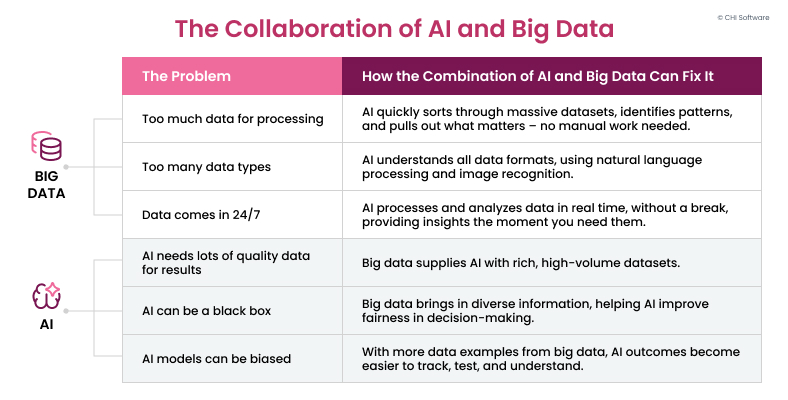
Together, artificial intelligence and big data transform information overload into a strategic advantage.
How to Use AI for Big Data
Here’s some more good news: when artificial intelligence and big data are combined, they don’t just cover each other’s weak spots, but also create new opportunities to grow your business. Let’s take a look at what this combination can do.
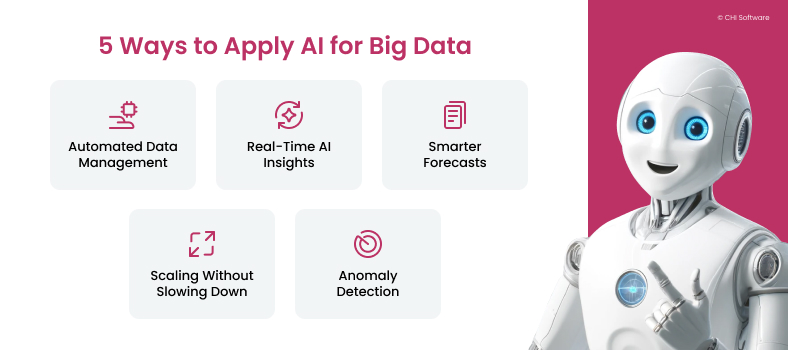
Here is how AI and big data can work together to automate processes, predict trends, and scale your business with real-time insights.
1. Automated Data Management
The job of working with, for example, big data in logistics can easily get out of hand due to its diversity and the lack of a standardized process. That’s why data management consulting, reinforced with AI tools like Apache NiFi, are key to automating data cleaning, classification, and integration. This way, businesses can manage information with ease while analyzing it in real time.
But there’s an even smarter way forward. CHI Software recommends using AI/ML development to create data pipelines: these are end-to-end systems that manage data from when it’s generated to when you use it – and it all happens in real time with minimal human intervention.
2. Real-Time AI Insights
AI analyzes information with high precision, making it a reliable tool even for industries where accuracy is critical. For example, big data in healthcare collects all of a patient’s metrics, while AI can trigger an alert to staff and patients in case of any noteworthy changes. AI for large data sets in banking can scan thousands of transactions every second and detect possible cases of fraud.
You need to have three essential key components for effective big data analytics and artificial intelligence strategy:
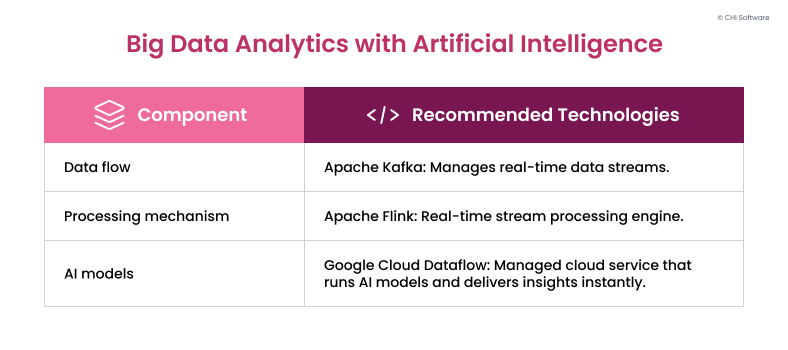
The core components that power real-time insights in AI and big data strategies and technologies CHI Software recommends using to manage them.
- Data flow: Create a system ready to catch and process enormous amounts of non-stop data flow;
- Processing mechanism: Find a tool or service that can process information streams without delays;
- AI models: Implement algorithms trained to detect anomalies and make decisions automatically.
You also need to establish a governance layer to make sure your data streams are secure and reliable. That’s where data governance consulting plays a critical role – it helps information feeding your AI models meet compliance standards while maintaining accuracy across the pipeline.
3. Smarter Forecasts
What if we told you that you could not only respond to changes in real time, but also make predictions about customer requests or changes in the market? That’s the power of machine learning (ML): it can analyze huge amounts of data, spot hidden trends, and use those patterns to forecast what’s likely to happen.
At CHI Software, we’ve worked with machine learning for vast data sets across industries, and our go-to tools are Scikit-learn and LightGBM. If your projects require deeper image recognition or voice processing, we recommend going straight to the more powerful ML field – deep learning. TensorFlow and PyTorch are powerful and flexible tools for building deep learning models.
AI and Data Engineering: A Game-Changing Collaboration
Read more
4. Scaling Without Slowing Down
Over time, your business will grow, and you will start to amass more and more data. Here’s how using AI algorithms can save your business processes from slowing down and your team from headaches:
- Smart load balancing: AI can distribute the load across cloud infrastructure instead of having a single server managing everything;
- Automatic scaling based on traffic: AI-powered cloud platforms can automatically detect increases in data load and immediately launch additional servers or resources. When the peak subsides, cloud platforms scale back, so you only pay for what you use;
- Serverless data processing: we often recommend implementing serverless models for high-load environments. “Serverless” means you don’t have to manage servers manually. The cloud provider automatically allocates resources exactly when they are needed.
5. Anomaly Detection
Security matters in every field, and the relationship between AI and big data can bring you more benefits than you might expect. AI can monitor security at all levels: detecting fraud, improving cybersecurity, and controlling production quality.
There are many approaches and tools to ensure maximum security when using AI, and we suggest you focusing on the following:
- Isolation forests can find rare events by isolating anomalies from normal data clusters;
- Autoencoders are a deep learning technique where AI tries to compress and reconstruct data – anomalies stand out because they don’t reconstruct well;
- ELK (Elasticsearch, Logstash, Kibana) Stack provides real-time log monitoring, such as detecting strange login attempts or system failures;
- Azure Anomaly Detector or Amazon Lookout for Metrics automatically learn patterns in your business metrics and detect unusual events.
These five wins are just the start! Let’s talk about what AI can do for your data.
Contact our team
How to Start Small with Big Data: CHI Software’s Advice and Expertise
We understand that combining AI with big data can seem like a huge and expensive transformation for your business – but trust us: getting started can be a breeze if you just follow our recommendations.
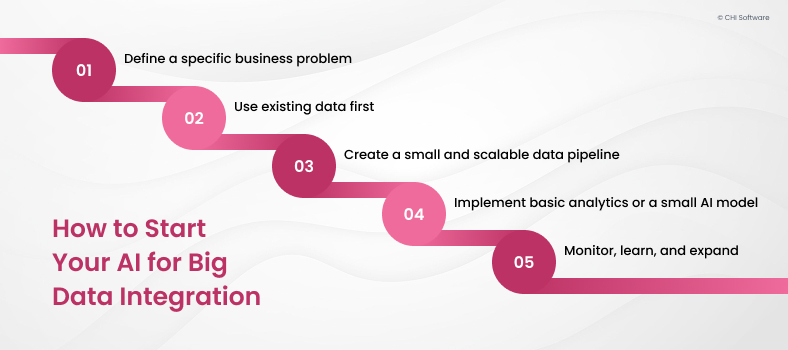
These five easy steps can help you get started with AI and big data without breaking the bank or investing in large infrastructures.
Step 1: Start With a Specific Business Problem
Over the years, CHI Software has found that clear goals are the driving force for businesses and greatly simplify the work for engineers. Therefore, the first step isn’t choosing infrastructure or tools — but rather defining your focus around a specific goal.
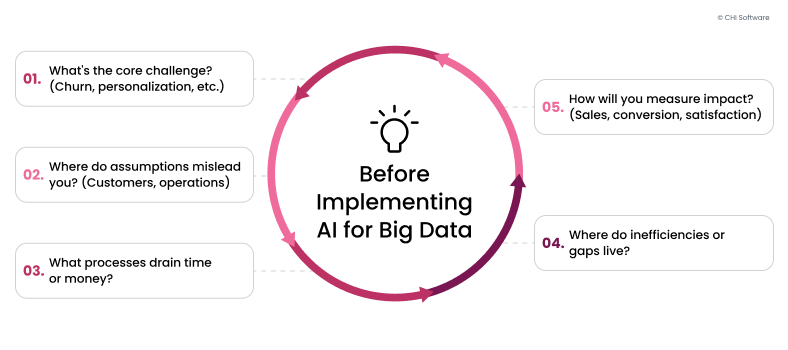
Try to give an answer to these key questions to pinpoint areas where AI and automation can make a real impact.
For example, fast-growing FoodTech company approached us with a clear task: to improve their real-time financial reporting. CHI Software redesigned their BI reports and provided ETL data services, ensuring daily transparency of profits and losses without disrupting operations. As a result, the company gained a 40% acceleration in data processing and real-time strategic analytics – all thanks to a clearly defined problem and a set goal.
Let CHI Software help you connect problems to solutions.
Start smart
Step 2: Use Existing Data First
There is no need to start collecting huge amounts of new data right away. You probably already have enough valuable information in your CRM, website logs, or production systems.
One of our clients, a venture company specializing in stock market research, needed to refine its data collection process to find top-performing startups. Instead of creating new data sources, we automated and structured the existing API and applied basic ML models for classification. The company achieved 100% automation of data collection and accelerated its ability to make investment decisions without the need for new resources.
Step 3: Create a Small and Scalable Data Pipeline
Data pipeline development collects raw data from various sources in order to transform and transfer it to storage systems. To create a data flow, you need infrastructure to collect, process, and store your data. But don’t worry: it’s not as complicated as it may seem.
With every project we see how companies today are choosing lightweight cloud solutions as a simpler, faster way to build data pipelines supported by data modeling services that ensure consistency and accuracy from the start. AWS Glue, Google Cloud Dataflow, or Azure Synapse have many advantages:
- You don’t need make a heavy investment up front, and pay only for what you use;
- Cloud solutions are ready to deploy quickly, meaning you can start seeing results sooner;
- These platforms can easily scale to handle increasing data volumes.
This way, your company wins: you get a reliable data pipeline without the cost of building an expensive, full-scale big data infrastructure from scratch.
Step 4: Implement Basic Analytics or a Small AI Model
You are not obligated to create an entire big data and machine learning department to start enjoying the benefits of AI: sometimes small but effective solutions bring an immense boost. How might it be possible?
We’ve created lightweight ETL channels and also provided data migration consulting to ensure smooth transitions, which resulted in 50% faster ad evaluation and a 30% savings on infrastructure costs.
Step 5: Monitor, Learn, and Gradually Expand
Don’t rush into building a massive system with a five-year plan in mind. The most successful big data projects usually evolve step by step – so try to focus on your current needs and let growth happen gradually.
We recommend the following approach:
- Launch: Start with a small and manageable project (e.g., implementing a basic machine learning model);
- Learn: Use the outcomes of your project to understand what works and what needs improvement;
- Tune: Refine system based on your observations: improve data quality, optimize processes, or add new data sources;
- Scale: Once you are confident, then you can expand the project by connecting more data, adding additional automation, and setting more ambitious goals.
For long-term success, businesses often rely on DataOps services to automate monitoring and ensure that analytics can scale together with business needs.
We’ve seen firsthand that even small steps can bring big results. A global marketing company approached CHI Software with a request to optimize its business analytics environment. With just a small investment in AI innovation, the company managed to halve their reporting times and saw data scalability grow by fivefold when they automated just their core analytics workflow.
Conclusion
At CHI Software, we are confident that choosing between big data vs AI is no longer a dilemma, as their synergy can offer faster analytics, real-time decision-making, accurate predictions, and reliable security.
We also believe that the future belongs to those who know how to combine big data with AI – and CHI Software can help you do exactly that! We support companies to implement big data in AI at every stage, from the initial steps to advanced problem-solving.
Don’t just explore the possibilities – start building with a team that knows how to deliver.
Work with CHI Software
FAQs
-
How long does it take to implement an AI solution powered by big data with CHI Software?

Your project's timeline will depend on the scope and available technology infrastructure. Small projects with basic AI algorithms can take four weeks. In contrast, large-scale solutions with bots, data analytics, and new pipelines can take months to develop.
But if you have a specific problem you want to solve, you may not have to wait for an entire system to be built. Thanks to cloud tools and thoughtful planning, the uses of big data in AI can be launched quickly, saving you time and money.
-
Can CHI Software help integrate AI into our existing big data platform?

Of course! CHI Software can easily add on artificial intelligence to big data platforms you already use by building tailored data pipelines on top of your existing resources whether it's AWS, Azure, Google Cloud, or a customized local infrastructure.
-
What types of business challenges can AI and big data solve together?

By combining big data and artificial intelligence, businesses can:
- Automatically manage data;
- Receive information in real time;
- Predict customer needs and market changes;
- Grow without disruptions;
- Identify problems at an early stage.
-
How do I know if my current data infrastructure is ready for AI implementation?

To find out if your data infrastructure can support artificial intelligence for big data, start by asking yourself the following:
- Data quality: Is your data clean and well-organized?
- Data accessibility: Can your systems easily access data from various sources?
- Scalability: Can your infrastructure deal with increasing data volumes?
- Real-time processing: Can your system support timely data processing for AI applications?
- Security and governance: Are your data privacy and access controls in place?
- Resources: Do you have storage and computing power for AI model training and deployment?
If you don't have an exact answer to these questions, don't worry! When you consult with CHI Software, our team can evaluate your existing data infrastructure and provide you with clear recommendations to get you ready for success using AI.
-
What are common pitfalls when companies try to combine AI and big data, and how can we avoid them?

We have seen several common pitfalls that businesses can encounter when connecting big data to AI, so we provide you with our problem-solving list:
- Lack of a clear goal: A project without a goal can easily lose focus – ask your team what problems you expect to solve with AI and big data and what results you expect to see;
- Creating overly complex systems too early: Your team can become overwhelmed, and progress can slow down if you make huge, complex systems unnecessarily. It's better to create a small system that is easy to manage and then later expanding it as you gain experience;
- Using poor-quality or biased data: Inaccurate data leads to inaccurate predictions and decisions – so you should be sure to clean your data before implementing AI, and it is best to do so regularly;
- Creating systems that are difficult to scale: it will be hard for your business to grow if it uses a system that cannot be scaled – consider using cloud solutions for flexibility and instant scalability.
About the author
Sirojiddin is a seasoned Data Engineer and Cloud Specialist who’s worked across different industries and all major cloud platforms. Always keeping up with the latest IT trends, he’s passionate about building efficient and scalable data solutions. With a solid background in pre-sales and project leadership, he knows how to make data work for business.
Oleksandr holds a Ph.D. in Probability Theory and Math Statistics and has a strong background as both a professor and engineer. He's worked with leading services like AWS and Azure, bringing expertise in machine learning, databases, and web applications. With skills in Python, .NET, JavaScript, and more, he's well-versed in building and optimizing tech solutions.
Rate this article
30 ratings, average: 4.86 out of 5









